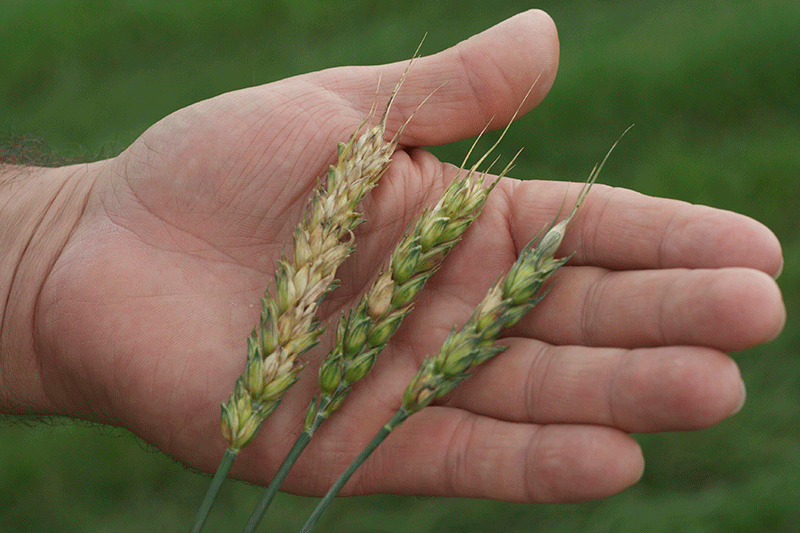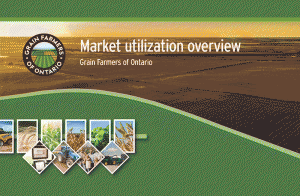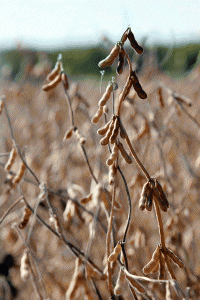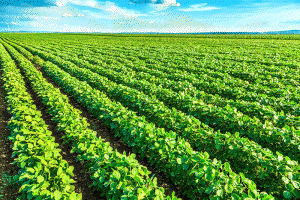Mitigating mycotoxins
EARLY DETECTION

MYCOTOXINS are toxic chemicals produced by fungi that infect crops. Some of the mycotoxins most commonly found in grain include Aflatoxin, Deoxynivalenol (DON), and Ochratoxin. They have a significant negative economic impact on the Ontario grain industry, yet there is currently no cost effective, efficient, and reliable way to sample and detect them on-farm. Grain is sampled after it leaves the farm gate at an elevator or processing facility. This leaves the grower unaware of the level of mycotoxins in the grain they’re bringing to the end user.
“Mycotoxins in whole grains are very difficult to monitor when grain enters the value chain after leaving the farm,” says Dr. Victor Limay-Rios, a research associate at the University of Guelph Ridgetown Campus who focuses on mycotoxin analysis. “Yet most of the best management practices for mycotoxins must be employed during grain production and on-farm storage.”
This is due to the fact that little can be done to remove these toxins by further processing, as they are not destroyed by factors such as heat.
According to Limay-Rios, mycotoxin contamination is a significant risk factor for consideration in the production of grain-based foods in Canada for domestic use and export. Foreign regulations and international and domestic guidance are tending to tighten allowable limits, but these regulations and guidelines aren’t consistent. With almost half of Ontario’s grain and grain products exported to the USA, the development of preventive measures to mitigate the impact of these toxins during growing, harvesting, storage, and further processing is critical.
IMPROVED TESTING
That’s where new research to improve testing for mycotoxins comes in.
Currently, the Fusarium Damaged Kernels (FDK) method visually assesses Fusarium damage in wheat, which can gauge the level of mycotoxins present. The ELISA, or enzyme-linked immunosorbent assay method, tests for the level of deoxynivalenol (DON) in the grain produced by the Fusarium in the grain; however, the relationship between FDK and DON is inconsistent by year and across grain market classes and tends to work better when handling very large grain lots.
“ELISA is one of the more affordable methods for detecting mycotoxins, and has the advantage that a large number of samples can be measured in batches. There are many ELISA and dipstick kits commercially available for the detection of DON in the parts per million range in grains,” says Limay-Rios. “However, there is not a reliable ELISA based method for the detection of Ochratoxin A (OTA) and false positives can be a major problem considering the low detection limit (parts per billion) for this toxin.”
“The ELISA test for DON is good, but takes a great deal of time and the results are only as good as the sample,” adds Dr. Art Schaafsma, professor of field crop pest management at the University of Guelph Ridgetown Campus. “There is resistance to sampling grain and testing for DON at elevators because of the cost, logistics, and sampling uncertainty, and there isn’t a commercially used test for OTA, so both a testing and sampling problem exist.”
A research project being led by Limay-Rios and Schaafsma, entitled “Mitigating mycotoxins in the Canadian food value chain”, will work to overcome these obstacles. It aims to develop a reliable protocol for testing DON and OTA during on-farm loading, and applying those methods to the value chain to manage contamination.
“Detecting both DON and especially OTA is a challenge,” says Schaafsma. “Typically the limit for DON in the grain is 0.5 parts per million. For OTA, we’re looking for even smaller amounts — as low as 0.5 parts per billion. Developing a reliable and cost effective test for OTA will work for both DON and OTA. For this study, we will be focusing on developing a test for OTA.”
“We want to provide tools to growers to test grain before they leave the farm so they’re aware of what they’re transporting to end users. Knowing what quality grain they have is crucial to making informed marketing decisions — maximizing their bottom line and time,” says Schaafsma.
DUST SAMPLES
The project will investigate using aspiration of dust as a way to obtain a continuous sample from a quantity of grain. According to Schaafsma, they hope to have the dust contents related to the grain contents to indicate contamination. Paired samples will be taken as bins or trucks are loaded with grain, by dipper cup sampling at regular intervals and by a continuous aspiration of the grain stream. Dust will be tested along with the whole grain for multiple toxins to determine which is the most sensitive, effective, and easy to use. The grain lots will be sampled and tested at the point of delivery by the normal commercial method employed at each location (FDK or DON test).
A newly developed testing method will be used to determine mycotoxin level. This new test uses aptamers (similar to synthetic antibodies — the current ELISA test uses animal-sourced antibodies) to make the test more specific and sensitive. Schaafsma says there is also a possibility that testing for both DON and OTA could be run simultaneously on different contaminants. This would mean that eventually, DON and OTA testing could be performed at the same time, decreasing costs and time for growers testing their loads.
On-farm testing for mycotoxins could open up doors for producers, speculates Schaafsma.
“We’re hoping to provide tools to wheat and corn producers to know what’s in their grain bins and trucks before they ship to end users or processors. This could be very beneficial to farmers and will help encourage better marketing decisions. If OTA in whole grain could be monitored during grain transfer by using dust as a surrogate, most of the serious mycotoxins could be detected at the source, making management much simpler further up the chain, and could perhaps even lead to an option for Identity Preserved load certification.”
For example, mycotoxin levels in corn this year were higher than average. Ethanol plants were unable to accept corn with a certain level of contamination — but growers wouldn’t get an accurate reading until they’ve already hauled the grain to the elevator or processor, risking a lower price than anticipated or being turned away altogether.
In addition, the project will also develop and distribute extension material on best management practices to manage OTA in grain handling and storage.
“The research will determine relative benefits of advances in genetic developments in seed, farming practices including forecasting, and fungicide application. Creating awareness with various industry sectors could improve self-directed monitoring, sampling, and identification of possible control points to avoid OTA formation in the grain handling and storage process,” says Schaafsma.
Testing price is not yet defined, but will likely be comparable to current tests. The project will conclude in 2018.
This project is funded by the University of Guelph; PepsiCo Foods; Mondelez; Kellogg; Prairie Oat Growers Association; Nestlé; Canadian National Millers Association; Western Grains Research Foundation; Food & Consumer Products Canada.
This project is also funded in part by the Government of Canada Agriculture and Agri-Food Canada, through Growing Forward 2’s AgriInnovation Program (AIP) — Industry-led Research and Development Stream. •



























